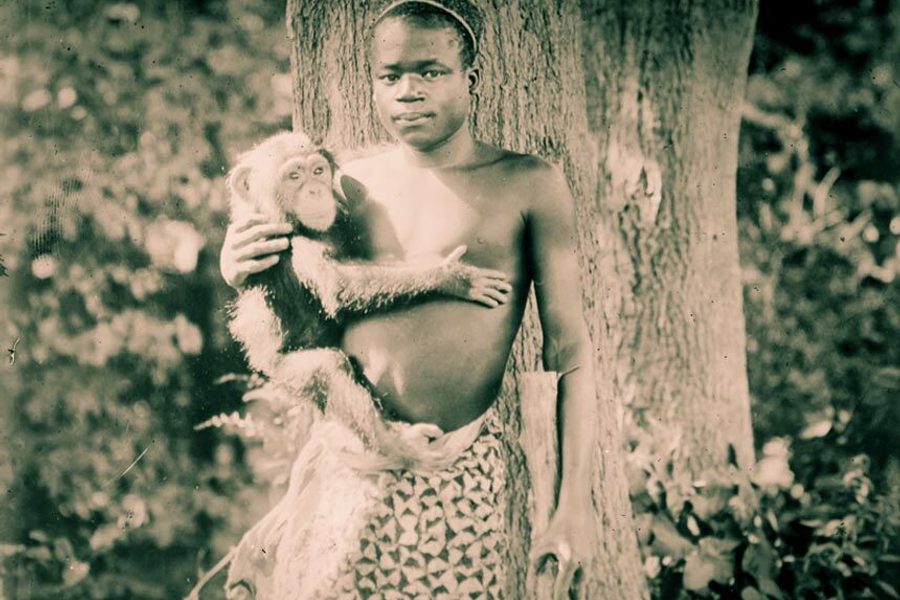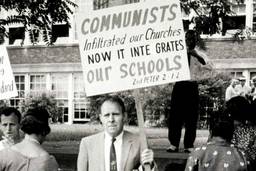A Century After Ota Benga’s Captivity, Elites Still Don’t Understand White Supremacy
Over a century after a Congolese man was displayed at the Bronx Zoo monkey exhibit, white elites still stubbornly believe they are benevolent, not supremacist.
Chris Lehmann

A condensed version of this piece appeared in the July print issue of In These Times.
The thwarted talk of race in America is, among many other things, testimony to the myth of progress. When those in the white citadels of cultural power aren’t declaring racism dead, they are, with a stunning lack of self-awareness, perpetuating the crudest kinds of racial reaction. In the immediate wake of the anti-police brutality protests in Baltimore in April, for example, when Michelle Obama delivered a relatively anodyne commencement speech at Tuskegee University pointing out the countless ways she and her husband had been perceived throughout their lives as reflexively angry, dangerously uppity or just plain dangerous, she was greeted by a deafening chorus of chidings from the pundit caste declaring how sadly counterproductive her dour observations were. Not since Dan Quayle tried to tie the depiction of single motherhood in a Candice Bergen sitcom to the root causes of the 1992 Rodney King riots had the American political establishment so concertedly and grandiosely missed the fucking point.
In order to better grasp our elites’ mind-bending capacity for greeting the stubborn evidence of white supremacy with alternate bouts of self-congratulation and petulant scolding, it’s instructive to recall that for most of the modern age, confident white opinion has cast itself as the guardian of reasoned comity between the races, when in fact, it is anything but. And there are few better places to begin than journalist Pamela Newkirk’s painstakingly researched and heartbreaking case study, Spectacle: The Astonishing Life of Ota Benga.
Newkirk’s book revolves around a single stupefying episode from the first decade of the New York Zoological Gardens (now known as the Bronx Zoo). In 1906, the zoo’s director, William Templeton Hornaday, teamed with an entrepreneurial former missionary named Samuel Phillips Verner to bring a new sensation before the zoo-going public: a small African man named Ota Benga, who had been transported from the Belgian Congo and advertised to Westerners as a rare specimen of the pygmy race. To drive home just how alien and exotic Benga was — and where he ostensibly fell on the evolutionary spectrum — zoo authorities housed him in the facility’s monkey house.
That’s right: In this seat of moneyed Northern cultural enlightenment, at the behest of a scientific community that prided itself on its dispassionate progressive mindset, Benga was displayed as though he were a monkey. Worse: Benga’s New York captors firmly believed that they were the man’s benevolent-minded caretakers; the small Bushman was a symbol of the colonial civilizing mission then known as “the white man’s burden.” A group of African-American ministers promptly protested the lurid display, agitating to get Benga placed in an orphanage in the Weeksville neighborhood of Brooklyn — then a center of black economic self-help and economic uplift — and arguing that he should receive schooling. But the keepers of polite New York opinion likewise couldn’t bestir themselves to think that grouping a human being among primates for public titillation could be a remotely harmful thing. “Pygmies,” the New York Times editorialized in its trademark tone of serene omniscience, “are very low in the human scale, and the suggestion that Benga should be in a school instead of a cage ignores the high probability that school would be a place of torture to him … . The idea that men are all much alike except as they have had or lacked opportunities for getting an education is now far out of date.”
Indeed it was — at least to judge by the scientific heavy hitters who promoted the Benga spectacle. When the black ministers agitating for Benga’s release were granted an audience with New York Mayor George B. McClellan Jr. (the son of a famed Union general), they were cursorily sent on their way, and told that the appropriate authority to consult was Madison Grant, a co-founder of the Bronx Zoo and the secretary for its governing body, the New York Zoological society.
Grant, as it turned out, was poised to become the most famous pseudo-scientific racist of the Progressive Era. Ten years after the Benga affair, he published The Passing of the Great Race, an unhinged but enormously influential tract that made the case for the eugenic winnowing of the human breeding stock so as to stamp out the baleful influences of “inferior races” in America’s gene pool. The book was lauded far and wide within progressive circles of the time, winning the plaudits of several pioneering anthropologists, Teddy Roosevelt (a racial moderate for his time but a certifiable nut job when it came to the racial paranoia of the eugenicists), and even The Nation magazine, which praised Grant’s “distinct qualities of originality, conviction and courage.”
In short, the ministers seeking to liberate Benga made zero headway with the zoo officials. Grant told them that the exhibition was scheduled to run only a few weeks — as if that mitigated the moral horror — and repeated a lie gaining currency among zoo officials as controversy mounted: that Benga was in fact a zoo employee, charged with the feeding and care of the apes and orangutans in the monkey house.
Benga’s tour at the zoo came to an end in the fall of 1906, and his patrician white captors were relieved to see him go; he had grown increasingly restive in his sideshow station. Crowds of heckling, bigoted zoo visitors had harassed, chased and poked at him. For his part, he took to threatening the zookeepers who sought to return him to his cage, and brandished a carving knife against them as they disrupted him in the act of undressing in public. As the controversy over his display swelled, Southern newspapers eagerly jumped into the fray to gloat over the hypocritical spectacle now convulsing “the sacred city of New York.”
Benga was eventually released into the custody of an African-American orphanage in Brooklyn’s majority-black Weeksville neighborhood and then transferred to a farm run by the charity in Smithtown, Long Island. Verner, his American sponsor, had offered to escort Benga back to the Congo, but was turned down flat. While Verner — the son of a Klan-allied Jim Crow politician in South Carolina — depicted himself as yet another of Benga’s selfless white protectors, in reality he had done nothing but exploit the Bushman for whatever seemed the most potent shock value of the moment. Very little that Verner had to say about Benga, or much of anything else, was provably true. Prior to the New York affair, he had debuted Benga for public viewing at the 1904 St. Louis World’s Fair as part of an exhibit of 11 African “pygmies,” claiming that his tribe’s practice of cosmetically sharpening their incisors was evidence of cannibalism. The voluble Verner, who’d spent several stretches in sanitariums to recover from mental breakdowns, also floated an account of Benga’s detainment in the Congo in which he, the white savior, rescued the hapless Bushman from cannibals preparing to make a meal of him.
Benga may have been bewilderingly adrift in an alien culture, and achingly lonely for his family, tribe, and homeland — but he clearly knew enough to refrain from any further contact with Verner. In defiance of the sage counsel of the New York Times, he pursued an education. Benga wound up undertaking studies at the Virginia Theological Seminary in Lynchburg, a Baptist school allied with the black nationalist thought of W.E.B. Du Bois. But the benefits of his studies didn’t come close to outweighing the traumas of his emigration and exploitation at the hands of the American science-and-spectacle complex. Benga’s young life ended abruptly and tragically.
Newkirk does an exemplary job of respecting the damaged dignity of her subject, only speculating about the likely forms of social shame and PTSD involved in Benga’s ordeal when scholarly research warrants doing so. In a way, though, the exasperating opacity of Benga’s tragic story is precisely the point — there is a scant record of what he actually felt, thought and said, because those were pretty much the last things on white America’s mind. The same lack of interest largely goes for the aggrieved protesters in Baltimore and Ferguson — and for Michelle Obama, for that matter. A full century after Ota Benga’s astounding, shameful saga, genuine racial progress remains as elusive as ever.









